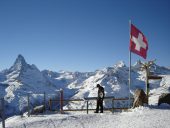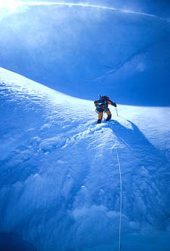Ripley attempts the Matterhorn….
Esteemed Hugo Ripley, a regular doyen of Explorers Club Franschhoek, has climbed out of journalistic retirement to contribute some words of wisdom to the ECB… of a past expedition, when he was a few kilos lighter.
The great heyday of Alpine mountaineering in the 1850s completely passed the Matterhorn by. It was considered unclimeable. If you arch your head backwards from its base camp and gaze up at the perfect pyramidal peak, its four sides vertically shorn off for 5 000 feet by the last Ice Age, you can see what the great mountain men were thinking.
Eventually a British mountaineer called Edward Whymper found a way up in 1865 but it took him five days of hell to get up and back after four of his team of seven fell off the summit. If you fall on the Matterhorn, you fall a very long way.
Since then the Matterhorn has passed into climbing folklore and thousands of mountaineers are drawn there each year; but unfortunately Whymper’s tragic ascent set a precedent and people still fall of the top with remarkable regularity. Like many of the world’s great peaks today any old wannabe mountaineer can pay a guide and do it and commercialisation is ensuring a lot of the wrong type of people on them. Four people died on the Matterhorn during my four-day stay in the area.
So it was with some concern that, as the veteran of one ice-free summit, I found myself dangling from a rope 13 000 feet up on a windswept, near-vertical icy ledge looking down at a pool of blood where the previous day’s victim had been struck by a rock. It was pointed out to me by two British army grunts who seemed to think it was, perhaps not funny, but not exactly sad either. I took one of those technicolour mental snapshots of my situation; the cataclysmic drop, the freezing wind, the blood and the width of the rope holding me. I threw in a quick mental note of the extent of my mountaineering experience and a laughable memory of having had some vertigo trouble in the lifts at work, and asked my guide to take me back where I belong.
You see the cliffs of the Matterhorn belong to a special type of person. They are the sort that enjoy bungee jumping out of hot air balloons and free-falling out of the stratosphere, and they love things like body-counts. Mountains, above 10 000 feet, are incredibly hostile places not intended for human activity; it is cold, there is no air and they are fraught with danger from avalanches, ice falls, crevasses, pulmonary edema and all manner of discomfort. To enjoy that much danger you do have to be a bit crazy. By the way, the army grunts abseiled off the summit, for a laugh.
Mountain climbing is certainly addictive. I started with Kilimanjaro, which is high, but it is never anything other than a hard hike. The thrill of Kili led me to sign up for Aconcagua, the highest peak in South America, which is also mainly just a tough hike, but with a ‘small’ difference. You have to walk on ice for about an hour and the Alps seemed like a good place to learn to walk on crampons and use an ice axe and ropes. But I think what I learnt is that it is this walking on ice or snow that turns you from the bog-standard hiker into a full-blown mountaineer – and those two pastimes could not be more different.
Zermatt, the famous Swiss skiing resort, serves as the starting point for Matterhorn climbers. Standing on the high street you are, of course, immediately struck by the mountain’s overhanging massivesness (it cannot be understated). In fact the people who market Zermatt have virtually given up trying to market the town itself, and it is mainly just known as the Matterhorn Region. Its unmistakeable outline adorns every bar of chocolate, cuckoo clock and everything else the Swiss are famous for making.
I had intended just to plod about on a few of the area’s mighty glaciers, but you soon find out that ‘normal’ people can climb the mountain. The Swiss Mountain Club just recommends that you be strapped to a professional and be able to endure a 12-hour rock climbing marathon without much oxygen.
I conducted a quick opinion poll on Zermatt high street and asked anyone with an ice axe strapped to a rucksack whether a novice should consider an ascent. Out of ten, their answers were unanimous – “Ya, go for it … you’ll have a laugh”. I had made the mistake of asking ten aforementioned mountain crazies for guidance.
Armed and safe with the knowledge that it was just a laugh, I booked up and caught the cable car towards basecamp at the HornliHutte at 3200m where you spend the night before to acclimatise to the minimal oxygen. There is an easy two-hour walk up to the hut but when you arrive the formidable north-east ridge (known with great restraint as the ‘normal’ way up) is much more ominously rearing up in front of you.
When you’re terrified the best thing to do is make a friend. This was not easy as the hut was full of horribly relaxed-looking people with slightly mad glints in their eyes. But I eventually latched onto a German, Wouter, who had more experience, but who was at least as scared as me. He showed me how to put a climbing harness on the right way round and we practised wearing crampons on an ice field near the hut. One of my shoelaces had come undone, so I bent down to tie it up. There was a polite “Aaghem” from Wouter when he noticed that I was kneeling on a fragile ice bridge over the only crevasse in sight. Oh dear, it was going to be a long 12 hours.
The guides arrive in due course and are a hardy lot, as you’d expect. They may only be attached to one client at a time for safety reasons (after a few multiple-client disasters) and the man with the task of hauling me up the mountain was Konrad Rosti. I was only his third South African client in a 15-year career (not surprising considering how the Rand translates into Swiss francs) and he took one look at my hiking boots and described them as ‘dancing shoes’.
It was his craggy face that was staring through the darkness at me in my bunk at 4am asking me to get ready – before I even knew I had gone to bed. I hadn’t slept because of this more or less permanent feeling of falling that I couldn’t get out of my head. It was well below freezing when we strapped into the harness and attached our headlights and a small statue of St Denise bids you a safe journey as you negotiate the first fixed ropes – fixed ropes, now there is something that can strike the workaday hiker as alarming. In fact there is no hiking on the Matterhorn at all – it is a 12-hour vertical rock scramble that puts every muscle in your body in a contest with every sinew.
The darkness protects you from yourself at first; it hides the drop, you are climbing upwards, so you look upwards and Konrad climbs in front hooking his rope around rocks to prevent his client from taking an early drop. Once the sun starts to rise a few pangs of vertigo set in as you realise the progress you have made, but all in all, I was pleased to have experienced some degree of bravery.
Rope, ice axe, fingers, foot, heave. That’s pretty much how it goes for four hours until you arrive at Solway Hut, an emergency refuge, impossibly perched on a rocky ledge at 12 000 feet. The lack of oxygen had started to give me a headache, so I asked Konrad for a break and inadvertently made a huge mistake. For the first time I really stopped and looked down. Zermatt was not far away, as I had expected to find, it was between my feet more than two kilometres straight down. It probably wasn’t the right thing to be thinking, but I couldn’t help wondering how long my body would be in the air for if I did put just one of my ‘dancing shoes’ in the wrong place – and that guy who did the tightrope walk between Manhattan’s Twin Towers was also much on my mind. The summit was only 400 vertical metres further on, but the route had begun to be punctuated by steps out over doomsday drops to get up to the next icy rock or ledge. The waves of vertigo were starting to crash through my head.
Eventually the gradient necessitates a long section of fixed ropes that leads up to the snow at a place called The Shoulder. The summit is right above you now and you have to put your crampons on for the final slog up an ice ridge with a heart-stopping plunge falling away just centimetres from both sides of your feet. Boom, more waves of panic. Just then I bumped into the British army grunts. They pointed out the blood and … boom … major attack of jelly legs … boom … and that was the end. Konrad knew I had lost the plot and before I knew it we had turned to go back down. Suddenly I couldn’t have cared less about the summit.
But here’s the thing; going up is a Sunday stroll compared to coming back down again. I hadn’t considered this on the way up. Heading down, the drop is all around you and you have to look at it. To make matters worse Konrad now has to go behind you under the laws of mountain guidance and that little psychological blow is like having a carpet pulled from under you. If you’re not used to walking on crampons, you have no idea if these eight tiny metal teeth are going to prevent your 90kg mass from a rapid descent to terminal velocity, or whether little 75kg Konrad would be able to prevent it. The 400 vertical metres back to the emergency hut took a very long time. I felt like an overloaded HGV negotiating a treacherous descent, it’s brakes jammed full on and sparks flying from the screeching metal and rubber – that is what was happening in my thigh muscles, to say nothing of what vertigo had done to my mind. I collapsed into the hut a broken man.
As I lay in the emergency refuge, tangled in ropes and climbing harness and unable to get my crampons off, visions of verdant meadows and lush fynbos began to blot out the harsh arctic reality as I tried to dream up a little cavern of tranquillity. But the peace was shattered, needless to say, by a couple of crazies who stumbled in to the hut to check if I had become one of their beloved statistics. They soon went away disappointed at finding I was still breathing.
For Konrad to get me out of the hut required probably more diplomatic nudging than he was used to, but having assured me that a helicopter rescue was unpractical on this ledge, we began tortuously picking our way back down the 800 vertical metres to the HornliHutte. It took another four more painful hours, during which time I passed my limit of endurance and I finished the climb in zombie mode.
But on the way back down the precipice the disappointment of not making the summit began to dissipate and by the time I reached the bottom I was actually quite elated. It had served a purpose – I had learnt that I’m nowhere near crazy enough to be a mountaineer and I was happy to be going back to hiking. On arriving back in Cape Town the first thing I did was to go straight for a ‘stroll’ on Devil’s Peak and it was marvellous.
It was Mark Twain who famously described the game of golf as the best way to ruin a perfectly good walk. I wonder what he would have made of the Matterhorn.




